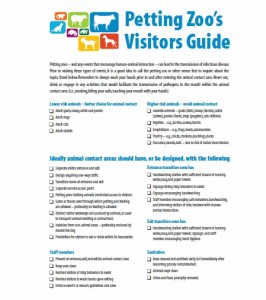A Nerstrand woman whose husband became ill believes that he was dealing with E. coli after attending the fair.
Bernadette Johnson said her husband, Greg, was stricken with a severe illness for six days. After talking with others, she was made aware of four of their friends who were struggling with a similar illness.
 “At the time we didn’t think anything of it,” she said. “But then we talked to other people, and a lot of people had the same symptoms.”
“At the time we didn’t think anything of it,” she said. “But then we talked to other people, and a lot of people had the same symptoms.”
The symptoms included cramps, spending a lot of time in the bathroom and overall not feeling well, symptoms similar to those of E. coli. However, none of them went to the hospital, as they figured it was a bug.
Johnson said Greg was in and out of the barns Thursday through Sunday during the fair and also went through the petting zoo.
The Minnesota Department of Health has diagnosed eight total E. coli cases, although only six of the eight attended the Rice County Fair. The Department of Health did not release the names of the other fairs involved; however, they have made them aware of the E. coli cases.
As the Department of Health continues to investigate the cases, they have confirmed that the E. coli strain found is E. coli O157:H7, the most severe. Of the eight cases that have been reported between July 9 and July 24, five have required hospitalization.
Best practices for planning events encouraging human-animal interactions
Zoonoses and Public Health
G. Erdozain , K. KuKanich , B. Chapman and D. Powell
http://onlinelibrary.wiley.com/doi/10.1111/zph.12117/abstract?deniedAccess
Educational events encouraging human–animal interaction include the risk of zoonotic disease transmission. It is estimated that 14% of all disease in the US caused by Campylobacter spp., Cryptosporidium spp., Shiga toxin-producing Escherichia coli (STEC) O157, non-O157 STECs, Listeria monocytogenes, nontyphoidal Salmonella enterica and Yersinia enterocolitica were attributable to animal contact. This article reviews best practices for organizing events where human–animal interactions are encouraged, with the objective of lowering the risk of zoonotic disease transmission.
A table of petting zoo outbreaks is available at https://barfblog.com/wp-content/uploads/2014/04/Petting-Zoo-Outbreaks-Table-4-8-14.xlsx.
